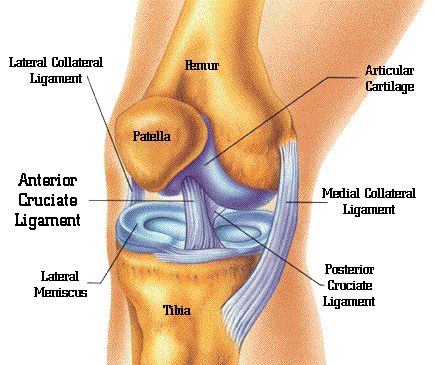Brief Outline of Meniscus Tear
The menisci are discs of fibrocartilage that cushion the knee joint. Tearing of the menisci can occur with forceful twisting of the knee, or may accompany other injuries such as ligament sprains. The unhappy triad is when a blow to the lateral side of the knee causes tearing of the medial collateral ligament, the anterior cruciate ligament, and the menisci.
Anatomy and physiology
The menisci is actually composed of two parts, the medial and lateral meniscus. The medial meniscus rests on the medial plateau of the tibia and the lateral meniscus rests on the lateral plateau. Each meniscus is C-shaped and provides cushioning and protection for the ends of the femur and tibia, acting as a shock absorber. The menisci help to distribute the weight evenly through the joint. Forceful twisting of the knee, especially if bent, can cause tearing of the menisci. This is often seen in sports that require a planting of the foot to quickly change direction. The medial meniscus is injured much more frequently that the lateral meniscus, mainly due to it being more securely attached to the tibia, and, therefore, less mobile.
Cause of Meniscus Tear
Forceful twisting of the knee joint, most commonly seen when the knee is also bent. May accompany ligament strains as well.
Signs and symptoms
Pain in the knee joint. Some swelling may be noted. Catching, or locking, in the joint.
Complications if left unattended
The loose bodies and jagged edges of a meniscal tear can cause premature wear on the cartilage at the ends of the bones and under the patella. This can lead to arthritic conditions and a fluid build-up in the knee joint.
Treatment
- Anti-inflammatory medication
- Surgery may be needed to repair the torn meniscus
Rehabilitation and prevention
After repair of a meniscal tear, it is important to strengthen the muscles surrounding the knee to prevent the injury from happening again. Strong quadriceps and hamstring help support the knee and prevent the twisting that might cause a tear. The muscles should be stretched regularly as well since tight muscles can also cause problems in the knee. After repair of a meniscus tear, weight bearing should be encouraged as tolerable, but as with any restart of activity it should be done gradually.
Long-term prognosis
A tear to a meniscus usually requires arthroscopic surgery to repair. The surgery requires removal of the torn edges of the meniscus but leaves the main body of the meniscus intact. Therefore, most meniscus tears heal fully with no long-term limitations.



